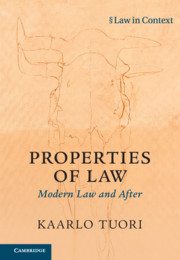Book contents
- Properties of Law
- Law in Context
- Properties of Law
- Copyright page
- Contents
- Preface
- Prologue
- Part I Sociality
- Part II Normativity
- Part III Plurality
- 11 The Black-Box View
- 12 Non-State Law
- 13 From Simple Diversity to Interlegality and Pluralism
- 14 Unity under Post-National Plurality
- Epilogue
- References
- Index
- Other Books in the Series (continued from page iv)
13 - From Simple Diversity to Interlegality and Pluralism
from Part III - Plurality
Published online by Cambridge University Press: 03 September 2021
- Properties of Law
- Law in Context
- Properties of Law
- Copyright page
- Contents
- Preface
- Prologue
- Part I Sociality
- Part II Normativity
- Part III Plurality
- 11 The Black-Box View
- 12 Non-State Law
- 13 From Simple Diversity to Interlegality and Pluralism
- 14 Unity under Post-National Plurality
- Epilogue
- References
- Index
- Other Books in the Series (continued from page iv)
Summary
Post-national plurality not only puts items on the global map of law that had no place in the black-box model of Legal Positivism: instances of non-state law, such as transnational, indigenous, and religious law. Post-national law also fundamentally alters the relations among instances of law, and annuls the self-sufficiency and reciprocal closure of the black boxes. The black-box model depicted the plurality of law as simple diversity, as mere coexistence of state legal orders, without any hint of either dialogical or conflictual relations. In contrast, post-national plurality invites us to conceive of the global constellation of law as interlegality where instances of law overlap and communicate in various modes.
- Type
- Chapter
- Information
- Properties of LawModern Law and After, pp. 239 - 256Publisher: Cambridge University PressPrint publication year: 2021

